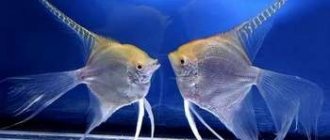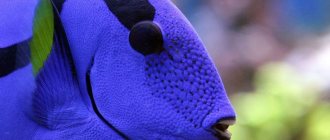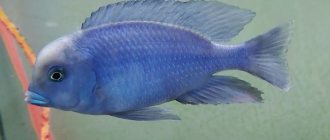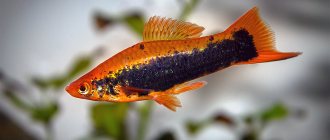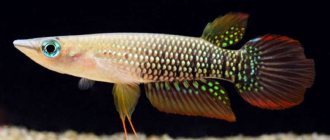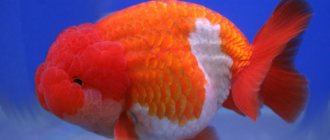5
(1)
The blue angelfish is a relatively new variety of the classic angelfish. It was created by a breeder from the Philippines named Ken Kennedy. Breeding such a variety was not an easy task. But breeders are constantly working on new morphs of fish, trying to create the most interesting variations. One of these can safely be attributed to the blue angelfish, which has received a soft blue color.
Description
The body shape of this phenotype is round and slightly flattened laterally. Therefore, experienced aquarists compare the blue angelfish with a crescent moon.
The shade of the scales and main fins is blue with iridescence. Therefore, when exposed to sunlight, the color changes slightly. The presence of the iridescence gene is indicated by a unique shade.
The fish have veil fins that are colored deep blue.
The length of large representatives of the fauna reaches 15 cm, and the height is about 20–25 cm. You can distinguish a male from a female if you pay attention to the shape of the dorsal fins.
Interesting Facts
Angelfish are one of the most popular ornamental fish, and have been bred by aquarists for over a hundred years.
These fish are very constant in their affections. They form permanent pairs, and it often happens that the blue angelfish dies after the death of the partner.
Angelfish are very shy, react to loud noises by making sudden movements, and can hit glass or decorations. Over time, they will get used to the sound background of the owner’s home, but at first they should be protected from such disturbances.
Maintenance in aquarium conditions
The blue angelfish is a schooling fish. Therefore, one tank will require from 4 to 6 fauna representatives. In the container they are independently divided into separate pairs.
To keep a blue angel you will need an aquarium with a volume of 100 liters or more. The height of the tank walls is 50–60 cm. The container is complemented with a lid so that the aquarium fish does not leave the selected tank.
Fine gravel and purified sand are used to fill the bottom. Shady vegetation and algae are planted along the perimeter. Grottoes, tunnels, snags and shelters are used as decoration. After all, aquarium fish actively move around the tank, hiding from other phenotypes.
To complete aquariums, lighting devices are used, which are supplemented with fluorescent lamps. The power level of lighting devices is determined individually. The container volume must be taken into account.
Habitat
It is not possible to meet blue angelfish in nature. This is a selective species that was artificially bred by man. In the natural environment, fish with a similar color would be quickly destroyed by predators.
The native forms of angelfish are the tropical rivers of South America - the Amazon and Orinoco. Typically, fish live in small creeks with a sandy bottom and dense thickets of plants. The water in these reservoirs is soft and acidic, which must be taken into account when keeping blue angelfish.
Water parameters
In order for blue angelfish to feel good, the following conditions are required:
- Acidity level – 7 units.
- Hardness level – 6–20 units.
- Temperature range – from 24 to 29 degrees.
Content in water whose temperature is below 24 degrees leads to a deterioration in the condition of fauna.
Blue angelfish require clean water. Therefore, a replacement is performed every 7–10 days. Compressors and siphons are used to clean the substrate from organic residues.
Containers with blue angels are equipped with filtration equipment, which is used to clean the container from food residues.
If appropriate care is provided, the life expectancy of aquarium fish reaches 7–10 years.
History of domestication
Ferdinand Schulz described the angelfish in 1823 and gave it the name Zeus scalaris. The famous Austrian zoologist named it in 1840 - Pterophyllum, which means “winged leaf” from Latin. Georges Cuvier described and named the fish Platax sciaris in 1931.
It was possible to bring fish to Germany in 1911; before they died. In 1914, they were propagated artificially for the first time; details were not disclosed until 1920, then aquarium hobbyists began breeding angelfish everywhere. It came to the USA in 1930. In the second half of the 20th century, breeders developed many breeds of this species.
Nutrition
The blue angel angelfish feeds on a variety of foods. Since aquarium fish are classified as predators and consume fry, experienced aquarists introduce live food into their diet.
Insect larvae, for example, coretra or crushed bloodworms, are introduced into the tank. Artemia and daphnia are periodically introduced into the container.
Tubifex is not used to feed blue angels, as this type of worm often carries infectious diseases. If they penetrate the body of phenotypes, they die.
From time to time, dry types of food are used as food, which are sold in zoological stores. Aquarists have access to tablet and granular food.
Stripes, why are they?
.
With their tall, slender proportions, Angelfish can swim far among plants where they are safe from larger fish. Black vertical stripes provide a protective coloration to blend in with their surroundings. Angelfish can turn their black stripes on and off at will.
If they are very frightened, they may turn pale and lie on the bottom for a while, as if in a faint. The best time to see angelfish without their black stripes is at night when all the lights are off. When the light is on, the fish will likely be almost white and they may be resting on the bottom.
Compatibility
Since the blue angel has a calm character, fish with the same disposition are added to it.
Those species that are distinguished by aggressiveness and pressure are not allowed to join angelfish. Astronotuses harm blue angels by damaging the integrity of their body. Macropods violate the integrity of the veil fins, gradually biting them off.
Small fish are not placed in the same container with scalars, since they are perceived as food.
Goldfish, mesonauts, as well as gours and lalius are excellent neighbors. They have similar body parameters.
Choosing suitable neighbors
Finding suitable neighbors for angelfish can be very difficult. You should immediately abandon predatory, aggressive neighbors, such as swordtails, cockerels, macropods, barbs - at best, angelfish will be left without fins, and may even be beaten to death. Too small neighbors like guppies or neon are also not the best solution. Angelfish love to diversify their diet with live food. If it is not enough, then the juveniles of the neighbors will be used.
The best choice would be catfish that live on the bottom, as well as mesonauts and some types of cichlids. Large, calm, peaceful, they can perfectly complement the aquarium without causing any trouble to the neighbors.
Breeding
Breeding blue angelfish is a process that only experienced aquarists can do. A separate container is prepared for parents, which is filled with vegetation and algae. Water parameters in the spawning tank:
- Hardness – 7 units.
- Acidity – 5–10 units.
- Temperature – 27–28 degrees.
To obtain offspring, a pair of fish is separated. It takes some time for future parents to get used to it. To lay eggs, they prepare a plant leaf, which is thoroughly cleaned. In order to speed up the process, the temperature is increased to 29 degrees. Change the aquarium fluid periodically.
Once the eggs are laid, aquarists watch for a while. This is how they determine whether parents care for their offspring.
Feed is administered to the fry for 7–8 days after they emerge. After all, after a week the fry move around the container. Artemia salina is used as feed. Such food is prepared at home or purchased at a zoological store.
After 2–3 weeks, crushed daphnia or freshwater plankton are introduced into the container with the fry. Small bloodworms begin to be fed after 3.5–4 months.
The tank with fry must be cleaned of organic residues and small particles. But the use of filtration equipment is prohibited.
The blue angel is an amazing aquarium fish with veil fins. It is introduced into both general and specific reservoirs. How long aquarists will admire the attractive and vibrant phenotypes depends on the correct care and maintenance.
Video about the life of angelfish in an aquarium
AdminAuthor of the article
Did you like the article?
Share with your friends:
Other types of angelfish
Natural forms of angelfish are not so easy to find on sale. But over the years, breeders have developed many variations of “angels”.
Artificial species of “angels” differ in the shape of their fins and body color. Conventionally, they are divided into several groups:
- spotted;
- striped;
- long-finned;
- solid.
Some of them have been known for decades, others were developed not so long ago.
Leopold's angelfish
One of the natural species is Pterophyllum Leopold, named after the Belgian King Leopold III. This species is distinguished by its smallest size , not exceeding 15 cm in length. But the elongated front part gave rise to a second name - “long-nosed”.
Leopold's color is quite modest - a chestnut-colored body with barely noticeable stripes. The proportional fins have a lilac tint.
Altum
Pterophyllum altum, also called Tall or High-bodied, High-finned, is one of the largest species among the angelfish.
The height of the body reaches about 50 cm. The color of the scales is similar to that of the common angelfish, but brighter and clearer.
The high-finned angelfish lives only in the Orinoco River basin.
You can distinguish Altum from other species by the following characteristics:
- high body and fins;
- protruding head;
- saddle-shaped depression between the forehead and mouth;
- small scale size.
The silvery body of the fish is vertically framed by three dark brownish stripes, slightly shaded.
Mostly wild-caught individuals go on sale. It is very rare to find fry bred in captivity.
Blue Angel
The fish, painted in a rich blue hue, are called “Blue Angel”. The most highly prized are individuals that lack dark stripes. The translucent fins are also blue.
Diamond
Angelfish painted in silver tones are called diamond. The scales of Pterophyllum scalare diamond shimmer in the light, resembling a diamond. An additional decoration is the transparent fins.
The diamond angelfish is related to goldfish. This species is used to breed new breeds of “angels”.
Manakupuru
Angelfish that live in the Brazilian reservoirs of Manakapuru are similar in description to ordinary “angels”. It is especially difficult to distinguish them in childhood. But as they grow older, the differences become more noticeable.
This species has a more elongated nose, there is no characteristic “hump” in the frontal part of males , and the fins do not bend back.
The stripes crossing the body of the fish differ in different colors: three stripes are pale, one is bright black. An orange edging runs along the edges of the fins.
The body of the fish is covered with silvery scales; on the back it is colored red. Due to this feature, manakapura is used to breed morphs with a red tint.
Platinum
One of the breeding forms of the common angelfish is the platinum angelfish. It received this name due to the noble silver-steel shade of its scales.
The dark stripes on the body of fish that are characteristic of most species are absent in this species.
Pearl
Thanks to a recessive gene, the pearlescent color of angelfish was obtained. The pearl angelfish is distinguished by light-colored scales shimmering with silvery highlights. On dark specimens the highlights are not noticeable, so they are less valuable.
Golden
Mother-of-pearl scales with a golden tint without the usual stripes distinguish this species from its wild ancestor. The shorter fins lack pigment, making them transparent. The body of golden angelfish is large, its length can reach 25-26 cm.
Marble
Silvery and black spots of varying sizes and shapes cover the scales of angelfish, giving them a marbled appearance.
Marble fish are much smaller than standard specimens, so a smaller aquarium is selected for them.
Bicolor
One of the most unusual and rare species of cichlids is Scalare bicolor (bicolor). The shape and size of these fish do not differ from ordinary ones, but they lack the usual stripes.
The body is painted in only two colors - black and silver, between which there is a clear boundary at the base of the tail. The front part of the body of individuals is light, and the back part is dark.
Leopard print
Black and silver spots, evenly scattered over the body of the fish, make it look like a predatory cat. Thanks to this color, the angelfish received the name – leopard angelfish.
Birch
The silvery body of the angelfish with characteristic dark stripes running vertically resembles a white birch tree. This was the reason for the name of this species - birch angelfish.
Striped
The striped cichlid, nicknamed the "zebra", has many bright transverse stripes.
What distinguishes them from the natural species is the number of stripes, of which the “zebra” has much more and is much more pronounced.
Red Devil
One variety of red angelfish, bred from the red-headed cichlid (koi), was named "Red Devil" due to the bright red color of the body.
The fish become completely red after the first year of life. This is achieved by adding special food to the fish’s diet that enhances color.
The most expensive specimens lack stripes and spots of other colors. The fins are colored golden.
Green Angel
One of the selected species of angelfish is a fish with a greenish color, nicknamed the “Green Angel”. These individuals do not have traditional stripes. Instead, elongated spots are scattered throughout the body.
The fins, like the scales, have a green tint, and under the light they become emerald in color. To preserve color, it is recommended to add coloring enzymes to the food.
Pink
Pink angelfish were born thanks to geneticists specializing in the creation of new artificial species of aquarium fish.
Pink individuals illuminated by UV lamps glow brightly, changing color from pink to purple.
Black
American breeders from Detroit in 1957, as a result of numerous experiments, obtained a new form of cichlids - the Black Velvet angelfish, also called Ludwig angelfish. Fish of this subspecies are characterized by a completely black color without light or silver spots.
Blue
Filipino aquarist Ken Kennedy managed to isolate the blue gene from angelfish. To consolidate this trait, he carried out work on crossing platinum fish with other species. Thanks to this, a new variety of cichlids was obtained - the blue angelfish.
The most popular of these species is the Pinoy angelfish. The body and fins of these individuals are painted a single blue color.
Red
Obtaining red angelfish consisted of several stages. First, breeders bred Koi angelfish with black, yellow, and red spots on their bodies. From these, individuals with reddish scales were selected. Crossing was carried out until fish colored reddish were obtained.
To maintain the red tint of the scales, carotenoids are added to the fish food.
Dantum albino
The Peruvian angelfish Rio Nanay became the progenitor of the albino form of cichlids Dantum albino (Dantum Skalare albino).
The white fish with red eyes is endowed with long, wide fins, which makes it much larger than ordinary angelfish. The lack of melanin, which protects the eyes and skin, forces albins to avoid light. These individuals feel comfortable only in aquariums shaded by vegetation, snags, and stones.
Paraiba
One of the artificially bred species of angelfish is the paraiba or phantom. The presence of a double asexuality gene was the reason for this name.
One of the differences between the Paraiba and ordinary angelfish is that the fins (caudal, anal) are not curved, but straight . The body of the fish is covered with bluish-silver luminous scales.
Koi
White “angels” with black and yellow spots scattered over the body, reminiscent of koi carp in color, are called Koi angelfish.
The spots on the head and back are colored red. Each individual has an individual pattern.
Jacobin
One of the elegant and exotic types of angelfish is the Jacobin. It is distinguished by a short body resembling a heart. The Jacobin has higher fins than its cousins. Therefore, the body of the fish seems more elongated vertically.
The Jacobin can be of any color. There are white, black, and silver individuals. The caudal fin can have a regular or veil shape.
Rio Nanay
The Nanay River, flowing in the north of Peru, is the birthplace of one of the natural forms of angelfish - the Rio Nanay or, as it is also called, the Peruvian red-spotted one. The fish received this name due to the red-brown spots covering the light silvery areas of the body.
In addition to the spots, the body of Peruvian individuals is crossed vertically by four thin dark stripes. The surface of the gills is decorated with turquoise spots.
Dwarf
Sometimes non-compliance with the conditions of detention, errors when feeding angelfish lead to the fact that the fish stop growing. As a result, a new form is formed - dwarf. Externally, mini-angels are no different from ordinary angelfish.
Veiled angelfish
One of the most attractive types of angelfish is a fish with a veiled body shape. Representatives of this species differ from their counterparts in the shape and size of their fins.
The elongated translucent fins look very impressive. In addition, the dorsal fins are slightly curved, and the ends of the rays of the caudal fin turn into lush brushes.
Due to the enlarged tail part, the length of some individuals exceeds 15 cm. The lower and upper fins are quite high and retain their shape when moving, without dangling back and forth.
As a result of crossing representatives of this form with fish of different colors, it resulted in the formation of trailing angelfish of different colors.
